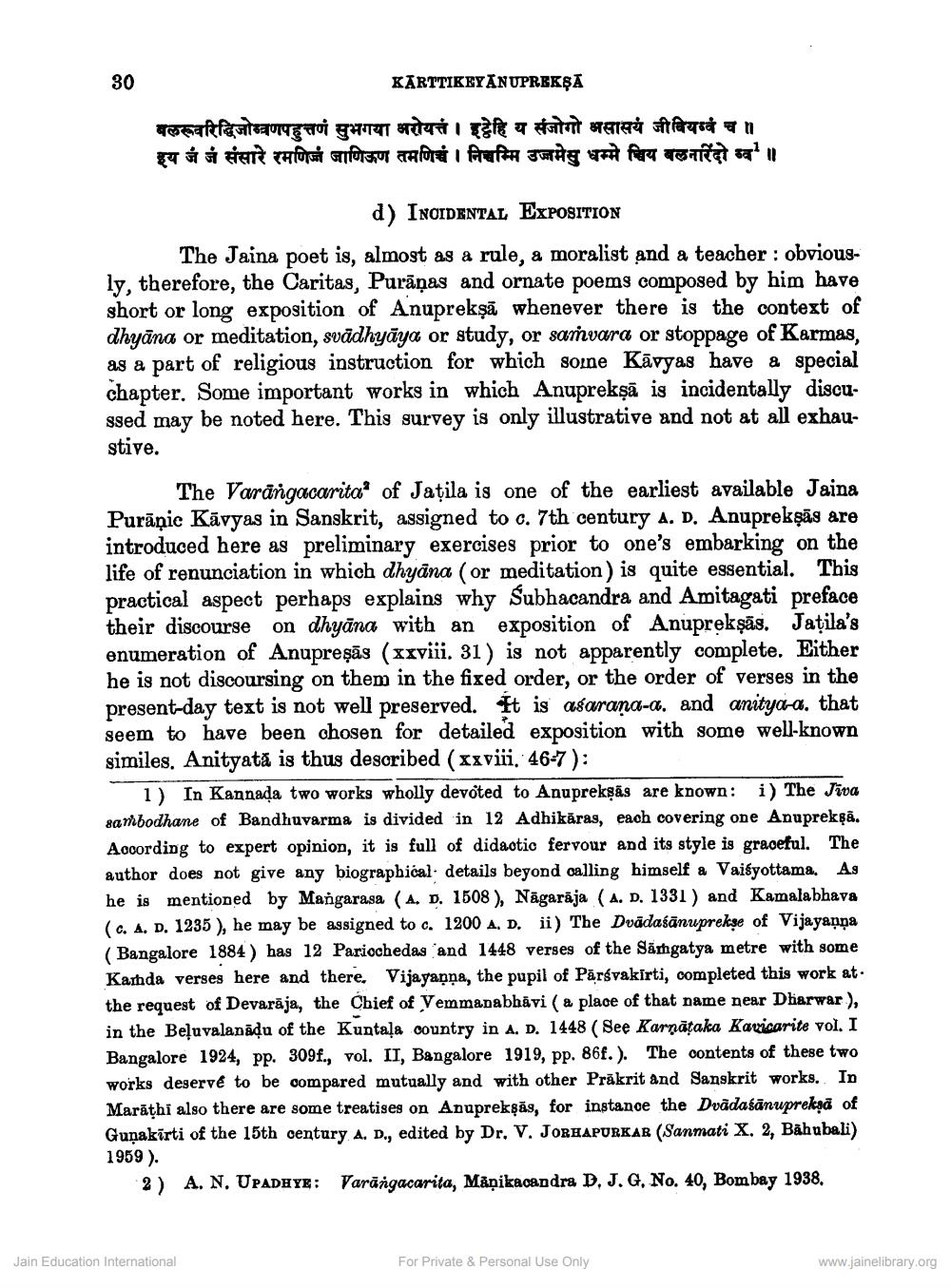________________
KĀRTTIKEYANUPREKSA
बलरूवरिद्धिजोवणपहुत्तणं सुभगया अरोयत्तं । इटेहि य संजोगो असासयं जीवियग्वं च ॥ इय जं जं संसारे रमणिज जाणिऊण तमणिचं । निश्चम्मि उजमेसु धम्मे चिय बलनरिंदो व॥
d) INCIDENTAL EXPOSITION The Jaina poet is, almost as a rule, a moralist and a teacher : obviously, therefore, the Caritas, Purāņas and ornate poems composed by him have short or long exposition of Anuprekşā whenever there is the context of dhyāna or meditation, svādhyāya or study, or samvara or stoppage of Karmas, as a part of religious instruction for which soune Kavyas have a special chapter. Some important works in which Anuprekşā is incidentally discussed may be noted here. This survey is only illustrative and not at all exhau
stive.
The Varāngacarita' of Jatila is one of the earliest available Jaina Purāņic Kāvyas in Sanskrit, assigned to c. 7th century A. D. Anuprekşās are introduced here as preliminary exercises prior to one's embarking on the life of renunciation in which dhyāna (or meditation) is quite essential. This practical aspect perhaps explains why śubhacandra and Amitagati preface their discourse on dhyāna with an exposition of Anuprekşās. Jațila's enumeration of Anupreşās (xxviii. 31) is not apparently complete. Either he is not discoursing on them in the fixed order, or the order of verses in the present-day text is not well preserved. It is asarana-a. and anitya-a, that seem to have been chosen for detailed exposition with some well-known similes. Anityată is thus described ( xxviii, 46-7):
1) In Kannada two works wholly devoted to Anupreksās are known: i) The Jiva sambodhane of Bandhuvarma is divided in 12 Adhikāras, each covering one Anuprekşā. According to expert opinion, it is full of didactic fervour and its style is graceful. The author does not give any biographical details beyond calling himself a Vaišyottama. As he is mentioned by Mangarasa (A.D. 1508 ), Nāgarāja (A.D. 1331 ) and Kamalabhava (C. A. D. 1235), he may be assigned to c. 1200 A. D. ii) The Dvādaśānuprekse of Vijayanpa (Bangalore 1884) has 12 Pariochedas and 1448 verses of the Sámgatya metre with some Kathda verses here and there. Vijayaņņa, the pupil of Pārsvakirti, completed this work at. the request of Devarāja, the Chief of Vemmanabhāvi ( a place of that name near Dharwar), in the Beļuvalanādu of the Kuntala country in A. D. 1448 ( See Karnātaka Kavicarite vol. I Bangalore 1924, pp. 309f., vol. II, Bangalore 1919, pp. 86f.). The contents of these two works deserve to be compared mutually and with other Prākrit and Sanskrit works. In Marăthi also there are some treatises on Anuprekşās, for instance the Dvādaśānupreksă of Gunakīrti of the 15th century A. D., edited by Dr. V. JORHAPURKAR (Sanmati X, 2, Bahubali) 1959).
2) A. N. UPADHYE: Varāngacarita, Mäpikaoandra D. J. G. No. 40, Bombay 1938.
Jain Education International
For Private & Personal Use Only
www.jainelibrary.org




